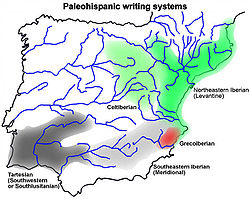
Back Escriptura ibèrica sud-oriental Catalan Südostiberische Schrift German Escritura ibérica suroriental Spanish Écriture ibérique sud-orientale French Escritura ibérica suroriental Galician Aksara Iberia Tenggara ID Scrittura iberica sudorientale Italian Iberisk alfabet NB Escrita ibérica meridional Portuguese Иберское письмо Russian



The southeastern Iberian script, also known as Meridional Iberian, was one of the means of written expression of the Iberian language, which was written mainly in the northeastern Iberian script and residually by the Greco-Iberian alphabet. About the relation between northeastern Iberian and southeastern Iberian scripts, it is necessary to point out that they are two different scripts with different values for the same signs; however it is clear that they had a common origin and the most accepted hypothesis is that northeastern Iberian script derives from southeastern Iberian script. In fact, the southeastern Iberian script is very similar, both considering the shape of the signs or their values, to the Southwestern script used to represent an unknown language usually named Tartessian. The main difference is that southeastern Iberian script does not show the vocalic redundancy of the syllabic signs. Unlike the northeastern Iberian script the decipherment of the southeastern Iberian script is not yet complete, because there are a significant number of signs on which scholars have not yet reached a consensus. Although it is believed that the southeastern Iberian script does not show any system to differentiate between voiced and unvoiced occlusives, unlike the northeastern Iberian script, a recent paper (Ferrer i Jané 2010) defends the existence of a dual system also in the southeastern Iberian script.
- ^ Leandre Villaronga, Jaume Benages, "Les monedes de l'edat antiga a la Península Ibèrica", pp 421-425.
- ^ Leandre Villaronga, "Corpus nummum Hispaniae ante Augusti aetatem"
- ^ Fernando Álvarez Burgos, "Catálogo general de la moneda hispánica"
- ^ Leandre Villaronga, José A Herrero, "Corpus Nummum Hispaniæ ante Augusti Ætatem"
- ^ Aloïss Heiss, "Description générale des monnaies antiques de l'Espagne"
- ^ MIB 159/14a, in P.P. Ripollès, M. Gozalbes (ed.), Moneda Ibérica (MIB), Valencia, https://monedaiberica.org/v3/type/2194 [accessed 4/6/2023]
© MMXXIII Rich X Search. We shall prevail. All rights reserved. Rich X Search

